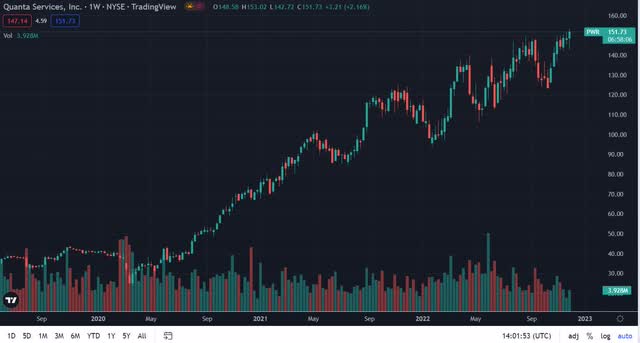aydinmutlu
Quanta Services, Inc. (NYSE:PWR) provides specialty contracting services around the world, and operates in three segments: Electric Power Infrastructure, Renewable Energy Infrastructure, and Underground Utility and Infrastructure.
Based upon the various elements associated with upgrading the electric grid in many markets, the company has been on a tear since March 23, 2020, when it traded at approximately $24.50. Since than it has exploded by more than 6x to trade at over $150.00 per share as I write.
With a hefty backlog, even the temporary supply chain challenges in its Renewables business won’t have much of an impact on the company in the near term, and further out, that segment should continue to grow.
In this article we’ll look at the latest numbers from its earnings report, the possibility of a correction after its massive run-up, implications of its huge backlog, and how the company is likely to perform going forward.
Latest numbers
Revenue in the third quarter was $4.5 billion, up $1.1 billion from the $3.4 billion in revenue generated in the third quarter of 2021. Revenue in the first nine months of 2022 was $12.7 billion, up $3.6 billion from the $9.1 billion in revenue from the first nine months of 2021.
Even though revenue growth was strong, it was lower than the company expected because of ongoing supply chain issues.
Net income came in at $156 million or $1.06 per share, down from the $175 million in net income, or $1.21 per share in the third quarter of 2021. Net income for the first nine months of 2022 was $338 million or $2.29 per share, compared to the $386 million in net income or $2.72 per share in the first nine months of 2021.
Adjusted earnings per share was a company record of $1.77.
Gross profit in the reporting period was $689 million, compared to the $534 billion in gross profit from the third quarter of 2021.
The company had free cash flow of $256 million in the quarter, up almost $300 million from the negative $40 million in free cash flow in the same quarter last year. The increase in free cash flow was attributed to collection of a large part of its receivables in relationship to a big Canadian electric transmission project.
Cash and cash equivalents at the end of the quarter were $215 million, down about $14 million from the end of calendar 2021. PWR has total liquidity of $1.8 billion at the end of the reporting period. The company had long-term debt of $3.9 billion at the end of the third quarter.
Management also announced it entered into a commercial paper program that will allow it to borrow up to $1 billion at any time.
It has a 12-month backlog of $12.4 billion, with a total backlog record backlog of $20.9 billion.
Some headwinds
One major headwind for full-year 2022 is the $300 million reduction in emergency restoration revenues, down over 30 percent from full-year 2021. This is of course an unpredictable source of revenue, and will fluctuate on an annual basis dependent primarily on weather patterns.
The significance to the company’s performance beyond revenue is it generates strong margins. While the company says margins will still come in at a range of 10.6 percent and 10.8 percent for the year, it would have been higher with more emergency restoration revenues.
A more embedded headwind is in relationship to its Renewables segment, which underperformed expectations in the quarter. The major reason for the underperformance was the belief “that the anti-circumvention moratorium would revitalize solar construction activities in the second half of the year.”
It didn’t work out like the company expected, and panel delays continue on because of tariffs.
Another headwind was in relationship to companies rethinking their project pipelines in response to positive changes associated with the Inflation Reduction Act. The consequence of that was to push a number of projects out from 2022 to 2023. This has resulted in the company lowering its full-year revenue guidance by $300 million in the segment, to about $3.8 billion. The decrease in revenue will also put downward pressure on margins in the quarter, for all of 2022, and probably in the quarters ahead until the issues are resolved
While this will put some downward pressure on the performance of the company in the near term, management believes the passing of the Inflation Reduction Act (IRA) will accelerated the growth opportunities in renewable energy infrastructure.
Concerning its Underground segment, that did well in the first nine months of 2022, with the PWR guiding for full-year revenue to be in a range of $4.2 billion to $4.3 billion.
That said, the company now believes there will be a pullback in the industrial sector in the fourth quarter based upon the deferral of maintenance in order to take advantage of the favorable market conditions they are now operating in. On the positive side, offsetting some of this is the performance of its Electric segment, which is projected to generate full-year revenues between $8.8 billion and $8.9 billion, up about $300 million from the prior range.
In regard to margin in Electric, as mentioned earlier, the decline in emergency restoration revenue has resulted in lower margin in the segment.
Conclusion
Quanta Services has been performing very well over the last couple of years as various countries upgrade their grids. It has a solid backlog and over the long-term, should continue to maintain growth momentum, although I think it’s going to be at a more modest pace than in the recent past.
With some of the short-term headwinds it’s facing and the long-term upward growth trajectory its share price has enjoyed, anything that is perceived to disrupt its growth in any sustainable way, will most likely result in a sharp sell-off in its stock.
Going back to November 2021 when the company had its first big drop from when it began its long upward climb starting in March 2020, it has had three such downward moves that were in a range of about $20 to $25 per share.
With the company in the middle of another upward move after the last correction, along with the short-term headwinds mentioned above and expected to continue into 2023 (with the exception of unpredictable emergency restoration revenues), I think the company could be on the verge of a correction that might take it beyond the $20 to $25 per share drop it has experienced over the last year or so.
I don’t think this should concern long-term shareholders, other than maybe thinking in terms of taking some profits off the table. For investors not in the company at this time, it could provide an excellent entry point that may not be seen again for a long time if its share price falls by more than it has in the last year.
The company is positioned well for long-term growth, but I think it’s going to struggle to repeat its performance over the last couple of years. A lot of the money has already been made, but with a strong enough pullback there is still a lot of potential for solid gains if investors get in at the right price.



Be the first to comment